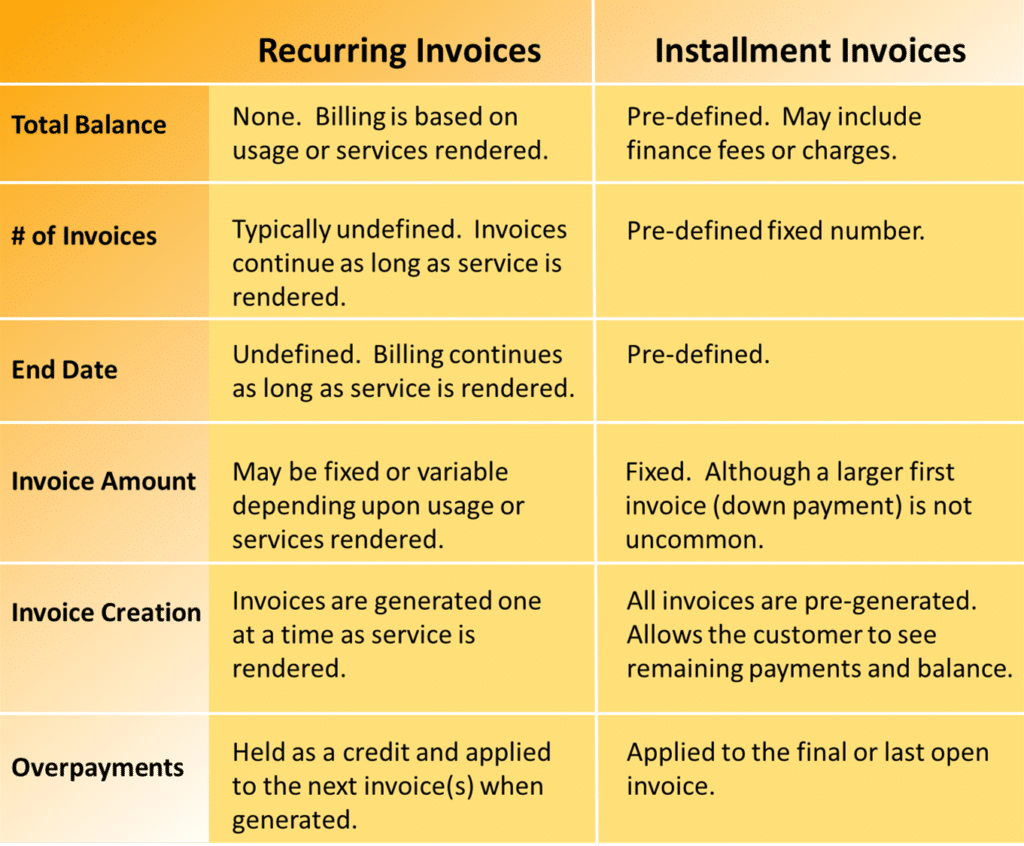Recurring vs Installment Invoices. What’s the difference ?
With ReliaBills, you can create single Invoices, Recurring Invoices, Estimates, and now Installment Invoices. On the surface, there does not seem to be much difference between a Recurring Invoice and an Installment invoice. Both invoice types generate invoices on a pre-defined schedule. Customers can make payments manually or automate payments. But after that, things get very interesting as the differences become pretty apparent.
Balance
For starters, Recurring Invoices have no sense of “total balance due”. Billing simply occurs on a regular basis as service is rendered. Whereas with installments, billing starts only after a total balance due has been clearly defined.
Number of Payments
Some Recurring Invoices are created with a defined or fixed number of invoices. However, it is most common for Recurring Invoices to have no defined number of payments. Billing simply occurs as service is rendered. Installment invoices ALWAYS have a defined number of invoices to be created.
Invoice Amount
Most often, the amount due for each Recurring Invoices is the same. However, the amount may vary based on usage of actual service rendered. This is often referred to as a “Variable” Recurring Invoice. The amount of every Installment Invoice, however, is pre-defined. That’s because the amount of each invoice is pre-calculated based on the total balance due and the number of invoices to be created.
Invoice Generation
Recurring Invoices are dynamically generated. That means, they are generated each week/month/year as service is rendered. If services is stopped, the invoices stop. Installment Invoices are all pre-generated. In this way, the customer can always see the remaining number of invoices and the balance due.
Overpayments
This is a subtle but very important distinction. If an overpayment is made to a Recurring Invoice, the overpayment is treated as a “credit” and applied to the next invoice when it is generated. With Installment Invoices, since invoices are all pre-generated, any overpayment is applied to the LAST invoice due.
Business Examples
Examples of business that use Recurring Invoices or Installment Invoices are all around us. We simply never realized the differences.
Recurring Invoices include your utilities, lawn maintenance, daycare, telephone, home security systems and many many more. In each case, invoices are sent on a regular recurring schedule. They stop when services are no longer being rendered.
Installment Invoices are commonly used when a large product or service is rendered such as a large landscape project or home remodel.

Accounting
Remember that, in most cases, Recurring Invoices are billing customer for work that has just been rendered. But with Installment Invoices, you are deferring payments for work that may have been completed. Be sure to consult your accountant to be sure that your are properly recognizing revenue and managing cash flow.

